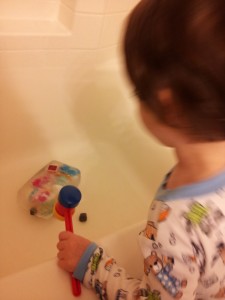So this past couple of weeks has been all about spending money:
Last week I bought the newborn starter kit of gDiapers. I also bought, and subsequently returned, some nursing bras online (my girls are not cooperative). I found a couple yesterday that fit (woo).
Last weekend Blake and I drove down to Orlando to get a changing pad and accessories from Babies ‘R Us, which was way too big for our IKEA changing table. So yesterday Blake and I drove down to Orlando again to pick up things from IKEA and return things to Babies ‘R Us.

The complete changing table.
But after all that, now the changing table stuff and the crib are all ready to go.
For the changing table, we bought the table from IKEA a few months ago so we needed the appropriately-sized changing pad and accessories, since the stuff we got from Babies ‘R Us didn’t fit – only an IKEA changing pad fits the IKEA changing table (go figure). So we go that (only $7), pad covers ($6 for 2), a pail that hangs over the side and a storage thing for wipes, etc. ($10 for both), a mobile that hangs from the ceiling ($5), and some mattress pad covers ($6 each). (Sharing prices with you because IKEA is awesome and cheap.) At Babies ‘R Us, we got a reusable wipes system, which includes a sterilizer/warmer and several bamboo cloth wipes (for when we’re changing diapers at home), as well as some biodegradable disposable wipes for when we’re not at home.

The crib all prettified. We have two sets, both are jungle themed.
For the crib, we bought the firm organic mattress from Target on Friday. Today we washed all the bedding and got it all together and prettified.
We also got a bathing kit, which consists of a sponge pad for baths up to 1 month, a ramp thing that fits in a sink for baths up to 6 months, and an adjustable tub for the rest of the baths.
I guess this part of the nesting process? I call it “OMG-there’s-only-three-weeks-and-we-need-our-shtuff-together” process, but I guess to each her own. 🙂
And you may have guessed from the photos that yes, both the crib and the changing table are in the bedroom with us. Since we have cats, it’s easier to keep them and their shedding out of one room than two.













 A new book, Born to Buy: The Commercialized Child and the New Consumer Culture by consumer expert Juliet Schor, explores the damaging effects advertising and marketing have on children. According to this breakthrough research, the advertising-saturated culture our children are exposed to is causing an array of psychosomatic symptoms.
A new book, Born to Buy: The Commercialized Child and the New Consumer Culture by consumer expert Juliet Schor, explores the damaging effects advertising and marketing have on children. According to this breakthrough research, the advertising-saturated culture our children are exposed to is causing an array of psychosomatic symptoms.




